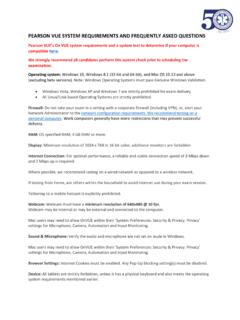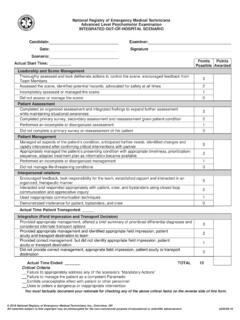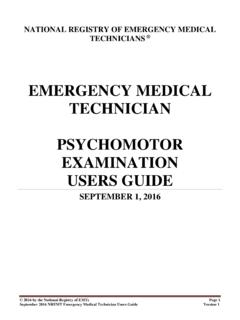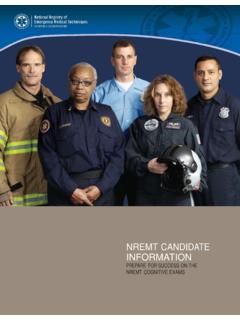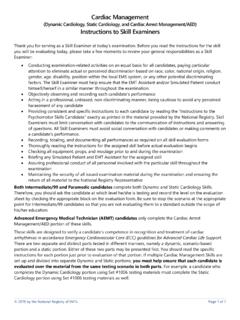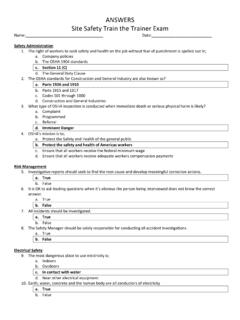Transcription of Airway, Respiration,
1 1. 2. Airway, Respiration, & Ventilation ..4. Ventilation .4. Ventilation Skills ..8. Capnography .. 9. Capnography Skills ..11. Oxygenation ..12. Oxygenation Skills ..12. Cardiovascular .. 13. Post-Resuscitation Care 13. Post-Resuscitation Skills .. 14. Ventricular Assist Devices . 15. VAD Skills .. 15. Stroke .. 16. Stroke Skills .17. Cardiac Arrest ..18. Cardiac Arrest Skills ..20. Pediatric Cardiac Arrest . 21. Pediatric Cardiac Skills ..24. Congestive Heart Failure (CHF) ..25. CHF Skills ..26. Acute Coronary Syndrome ..27. ACS Skills ..27. Trauma ..28. Triage ..28. Triage Skills ..29. Central Nervous System (CNS) Injury ..30. CNS Skills ..31. Hemorrhage ..32. Hemorrhage Skills ..33. Fluid Resuscitation ..34. Fluid Resuscitation Skills 34. Medical ..35. Special Healthcare Needs .. 35. Special Healthcare Needs Skills .. 38. OB Emergencies . 39. OB Skills.
2 41. Infectious Disease ..42. Infectious Disease Skills ..43. Medication Delivery . 44. Medication Delivery Skills ..44. Pain Management ..45. Pain Management Skills . 48. Psychiatric and Behavioral Emergencies .. 49. Psychiatric and Behavioral Skills ..52. Toxicological Opioids Emergencies ..53. Toxicological Skills ..55. Neurological Emergencies- Seizures ..56. 3. Neurological/Seizures Skills ..57. Endocrine Emergencies- Diabetes ..58. Endocrine Emergencies/ Diabetes Skills ..60. Immunological Emergencies, Allergic Reaction & Anaphylaxis ..61. Immunological Emergencies Skills ..62. Operations .. 63. At Risk Population .. 63. At Risk Population Skills .. 64. Ambulance Safety .. 65. Ambulance Safety Skills .. 67. Field Triage- Disasters/MCIs .. 68. Field Triage Skills ..69. Provider Hygiene, Safety, and Vaccinations ..70. Hygiene Skills ..71. Culture of Safety.
3 72. Culture of Safety Skills ..73. Pediatric Transport ..74. Pediatric Transport Skills ..75. Crew Resource Management ..76. Crew Resource Management Skills ..78. EMS Research ..79. EMS Research Skills ..80. Evidence Based Guidelines ..81. Evidence Based Guideline Skills ..82. References .. 83. 4. PARAMEDICS. AIRWAY, RESPIRATION, & VENTILATION. VENTILATION. ADULT & PEDIATRIC PATIENTS: 2 HOURS. INSTRUCTOR PREPARATIONS. National EMS Education Standards Review relevant material in a Paramedic text Review current AHA Guidelines Assemble skills laboratory materials: o Airway management trainer o Bag Valve Mask Resuscitator and assorted masks o Oropharyngeal Airways and tongue blades o Nasopharyngeal Airways o Airway devices ( , supraglottic airway, intubation equipment, etc.). o Oxygen or simulated oxygen/compressed air source o Suction unit with catheters and tubing o Airway lubricant o Automatic Transport Ventilator (if available).
4 O CPAP device o Airway skills evaluation form LEARNING OBJECTIVES. Differentiate between adequate and inadequate breathing Differentiate between respiratory distress and respiratory failure Differentiate between alveolar ventilation and minute ventilation Explain when to oxygenate and when to ventilate a patient Examine the effect of ventilation on venous return and cardiac output o Spontaneously breathing patient o Artificially ventilated patient Identify the use of automated transport ventilators when managing patients Discuss the AHA's position on routine suctioning of the newborn Demonstrate effective bag-valve-mask ventilation at a proper rate and depth Assess the advantages and disadvantages of various advanced airway adjuncts LESSON CONTENT. I. Minute ventilation a. The volume of air a person moves in and out of the respiratory system in one minute b.
5 Minute ventilation (MV) = Tidal volume x Respiratory rate i. Tidal volume (Vt) The volume of air a person moves in and out of the respiratory system in each breath ii. Respiratory rate (Frequency (F)) The number of times a person breathes per minute c. Example: 500mL of air x 12 breaths per minute = 6000mL/minute d. Explain adequate and inadequate breathing based on minute ventilation II. Adequate and inadequate breathing a. Must have an adequate minute ventilation (adequate rate AND adequate tidal volume). b. Inadequate breathing requires immediate management with positive pressure ventilation. i. Inadequate breathing is caused by 1. An inadequate tidal volume 2. An inadequate rate 3. A combination of both 5. c. Adequate breathing does not require positive pressure ventilation III. Alveolar ventilation (Va). a. The amount of air that moves in and out of the alveoli per minute b.
6 Alveolar ventilation = (tidal volume dead air space ) x respiratory rate in one minute i. Va = (Vt Vd) * F. ii. Example: (500mL of air 150mL) x 12 breaths per minute = 4200mL/minute c. The difference between minute ventilation and alveolar ventilation is important because alveolar ventilation is the volume of air reaching the alveoli that participates in gas exchange (what oxygenates the blood.) By increasing the rate of ventilation in a patient with shallow breathing (inadequate tidal volume) may maintain the minute ventilation near normal; however alveolar ventilation (gas exchange) will be inadequate. IV. Effect of ventilation on venous return and cardiac output a. In the normal patient, the negative pressure that causes inhalation facilitates venous return necessary for adequate cardiac output and perfusion. i. Cardiac output is the amount of blood ejected from the left ventricle in one minute ii.
7 Cardiac output = stroke volume x heart rate 1. Stroke volume = amount of blood ejected from the left ventricle with each contraction 2. Heart rate = number of times the heart contracts in one minute iii. Negative pressure during inhalation allows venous blood return to the right side of the heart, which is necessary for adequate cardiac output b. Artificial ventilation pushes air into the chest (positive pressure ventilation) increasing intrathoracic pressure i. 1 Death by Hyperventilation: A Common and Life-threatening Problem During Cardiopulmonary Resuscitation . ii. Increases in intrathoracic pressure impedes venous blood return to the right side of the heart iii. Excessive ventilation rates during positive pressure ventilation 1. Decreases cardiac output 2. Decreases vital organ perfusion iv. For adults, artificial ventilatory rates greater than 12 times per minute (one ventilation every 5-6 seconds) decrease cardiac output and perfusion 1.
8 Do not exceed a ventilatory rate of 10-12 times per minute (one ventilation every 5-6 seconds). 2. High artificial ventilatory rates (greater than 12 times per minute, one breath every 5-6 seconds) result in poor patient outcomes V. Respiratory distress vs. failure a. Respiratory conditions are dynamic i. Range from minor respiratory distress to respiratory arrest ii. Can be acute, chronic, or chronic with acute exacerbation iii. Signs/symptoms are dynamic and may change over time depending on the state of patient's disease process b. Many patients with respiratory diseases need only comfort care c. Important to know when exactly to provide an intervention (such as artificial ventilation). in order to increase the likelihood of patient improvement d. In respiratory failure, inadequate alveolar ventilation exhibited by i. Decrease in or excessively high respiratory rate 1.
9 Reduces tidal volume and amount of air available for alveolar gas exchange ii. Decrease in tidal volume (or both). 6. iii. Patients in respiratory failure are severely ill e. Must recognize the transition of a respiratory disease from distress to failure i. Deterioration in mental status , confusion, loss of gag reflex ii. Accessory muscle use, head bobbing, grunting, nasal flaring iii. Decrease in SpO2. iv. Cyanosis v. Hypercarbia VI. Continuous Positive Airway Pressure (CPAP). a. CPAP is used to provide better oxygenation to patients who are hypoxic i. Not designed to ventilate patients b. Reduces the effort for the patient to breathe, improves oxygenation and reduces hypercarbia c. Can prevent the exacerbation of respiratory distress or respiratory failure d. Applies positive airway pressures above atmospheric pressure during inhalation and provides positive end expiratory pressure (PEEP) during exhalation e.
10 Indications i. Patient needing ventilatory support who is in moderate to severe respiratory distress or early respiratory failure ii. Patient must be awake, able to obey commands, and have intact airway reflexes f. Contraindications i. Inability to maintain an open airway ii. Severe hypotension (systolic BP < 90). iii. A respiratory rate of less than 8 breaths/min g. The EMS provider needs to deliver assisted artificial ventilations to patients who exhibit deterioration in mental status because of hypoxia and hypercarbia VII. Automated Transport Ventilators (ATV). a. Intubated patients requiring artificial ventilation for a period of time may benefit from use of ATV, instead of BVM. b. Advantages i. Can be used for 1. Breathing and non-breathing patients 2. Patients in respiratory failure ii. Frees the rescuer for other tasks c. Adjustable settings provide i.
